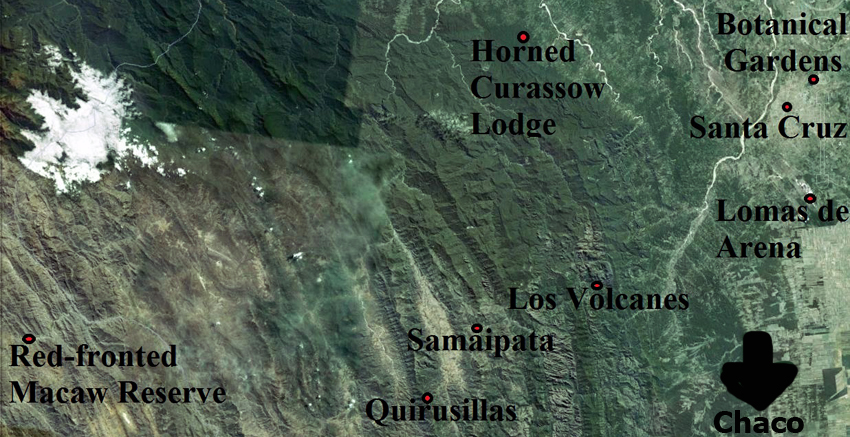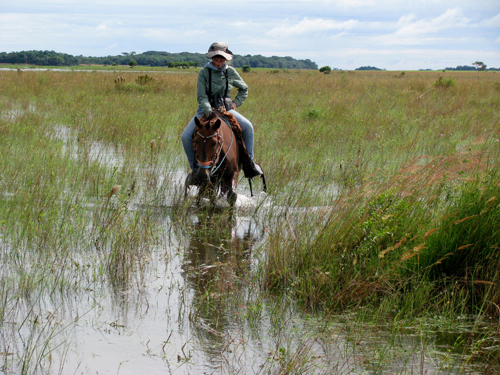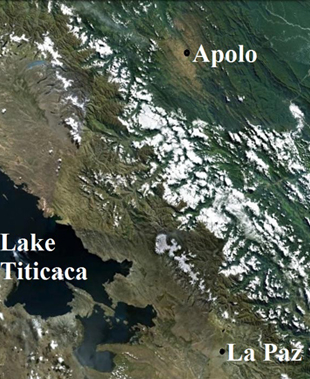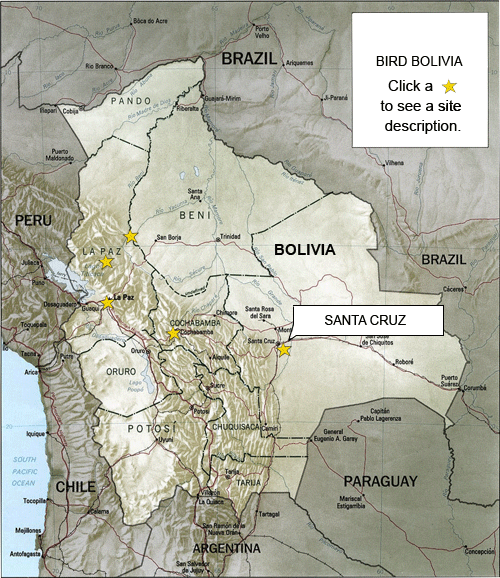|
Where to Watch Birds in Bolivia
By Bennett Hennessey and Lawrence Rubey
This guide is based on four central hubs: Santa Cruz,
Beni, Cochabamba, La Paz, and Rurrenabaque. Each has connecting main roads
with connecting daily busses and flights (La Paz and Santa Cruz
with international flights). Given the high altitude problems that
some experience arriving directly in La Paz, we recommend and have
placed the hubs in order of best acclimation to altitude, initially
with Santa Cruz and Beni (lowlands), Cochabamba (medium highlands), and finally La Paz
(very high, like many get sick high). Keep in mind American Airlines Miami based flights will allow you
to land in Santa Cruz and fly out of La Paz for the same price. See Bolivian Specialities for an idea of the birds you are most likely to see only in Bolivia and where.
SANTA
CRUZ AREA
The city of Santa Cruz de
la Sierra, often just called Santa Cruz, is found on the central western edge of the
department of Santa Cruz, almost in the middle
of Bolivia. Santa Cruz is the best place to start any kind of birding adventure in Bolivia
with excellent hotels and
unique birding sites within the city, all accessible by local taxi. Santa Cruz along with Rurrenabaque, are the entrance points to the Bolivian lowlands. They are perfect spots to rest up, prep up and
set off. Even only for a short visit to
Bolivia
,
the bird community around Santa Cruz is different enough to be worth a full
morning at the Botanical Gardens for the Bolivian Slaty.

CLOSE
TO THE CITY
Within the city of
Santa Cruz you can visit the sites of Lomas de Arena Municipal Park, Viru-Viru Airport, and Santa Cruz Botanical Garden with local micros and taxis. Lomas de Arena is sandy halfway in, so you might
need to walk the farthest bit.
OLD ROAD TO COCHABAMBA
The old
road to
Cochabamba travels from
Santa
Cruz west up the dry Andes of Bolivia. It
is paved up to Siberia. From Siberia to Cochabamba it is a dirt road that is in horrible shape, with poor upkeep and heavy truck abuse. We recommend not driving this part. From Santa Cruz this road can be part of a wonderful birding route, visiting different habitats and bird communities as you increase in altitude. At about 900 m snuggled within sandstone cliffs is the lodge Los Volcanes (2.5 hrs from
Santa Cruz). Also in this area is the Laguna Volcan which is a fancy hotel gold resort in distrubed habitat but with Andean Ducks on their lake. Further up is the town of Samaipata, where you could
visit Las Ruinas and with local
tour guide help Yungas de Samaipata. Santa Cruz has easy simple transportation to Samaipatat. The Northernmost Tucuman forest is a two hour drive from Samaipata in the area called Quirusillas, where you can also see the Tucuman Parrot. And further on you reach the Andean Dry Valley habitat with many endemics best to be seen at the spendid Red-fronted Macaw Reserve. And further west, the road travels up the moist higher Andes Yungas of Siberia, a very pleasant cloud forest.
NEW
ROAD TO
COCHABAMBA
From Santa Cruz you can take
the new road to
Cochabamba which passes through
Montero leading to the town of Buena
Vista (about a 3 hour drive). There are local trufi
taxis, which fill with passengers like a bus, that travel to Buena Vista where
you could visit the sites Buena
Vista pumping station and Hotel Flora and Fauna. The Southern-horned Curassow site can be then visited from
Buena Vista in car, but best to make arrangements in
Santa Cruz without a car.
CHACO
South of the city of Santa Cruz you can visit the Chaco. Chaco is a very hot habitat that undergoes a strong dry season, and then a moist rainy season. Most of the habitat is in Paraguay, but we have found that few birdwatchers visiting all the South American countries include Paraguay, thus this could be an important area to spend a few days. Taking the main recently paved and very comfortable highway #9 south from the city of Santa Cruz, you want to visit two areas, Lagunills del Chaco and Boyiube Chaco. On a Bird Bolivia 35 day tour in 2012 passing time in all the key habitats in Bolivia, the third highest species count record in a day was a morning in Boyuibe Chaco, and visiting Lagunillas del Chaco in the afternoon (the best day was in Sadiri Rainforest and the second in Barba Azul Nature Reserve).
OUTER
SANTA CRUZ
The Neol Kempff Mercado
National Park is also of interest for it Cerrado and Tropical
forest, though tourism infrastructure has not been kept up. Unfortunely Pantanal in
Bolivia
has no tourism
infrastructure, but you can visit Brazilian Pantanal and the Hycinth Macaw just
over the border of eastern
Bolivia.
BENI AREA
 The Beni holds three habitats of interest for birdwatchers; Beni Tropical Savannah Endemic Bird Area; Bolivian Cerrado; and Beni Tropical Forest. The Beni Tropical Savannah has two "acknowledged" Bolivian Beni Endemic species, with a plethora of subspecies suspected or obvious Beni proper species. The must see star is the Endemic and Critically Endangered Blue-throated Macaw, best seen at the Barba Azul Nature Reserve, a fantastic protected cattle-free tall-grass Beni Savannah and palm forest island reserve. A visit to this reserve should be combined with a one day visit to Trinidad to try and pick up some other Beni Endemics and future splits. The other popular tourist spot in the department of Beni is Rurrenabaque. From Rurrenabaque the Santa Rosa Beni Savannas can be visited within a few hours from the town. Given its rainforest tourism popularity it is dealt with in a different section. The Beni holds three habitats of interest for birdwatchers; Beni Tropical Savannah Endemic Bird Area; Bolivian Cerrado; and Beni Tropical Forest. The Beni Tropical Savannah has two "acknowledged" Bolivian Beni Endemic species, with a plethora of subspecies suspected or obvious Beni proper species. The must see star is the Endemic and Critically Endangered Blue-throated Macaw, best seen at the Barba Azul Nature Reserve, a fantastic protected cattle-free tall-grass Beni Savannah and palm forest island reserve. A visit to this reserve should be combined with a one day visit to Trinidad to try and pick up some other Beni Endemics and future splits. The other popular tourist spot in the department of Beni is Rurrenabaque. From Rurrenabaque the Santa Rosa Beni Savannas can be visited within a few hours from the town. Given its rainforest tourism popularity it is dealt with in a different section.
Within the department of Beni is also the city of Riberalta, which is the only home in the world for the Bolivian Endemic Masked Antpitta. Here you have access to Varzea forest. There is also tall forest in the area which is worth a short visit, but with no large protected areas or lodge facilities. For rainforest birds you are better of going to Rurrenabaque.
Bolivia's Cerrado will become a hot topic in future years as Brazil diligently destroys what it has. The Cerrado in Bolivia would appear to hold no country endemics, but many of the Cerrado specialists found across this habitats girth- which is mostly in Brazil. From Riberalta, you can visit two healthy yet remote Cerrado sites. The Cerrado sites in Noel Kempff Mercado National Park are no longer of easy access. The Los Lagos Lodge is located at the edge of the Beni grasslands, with a mix of savanna and Cerrado forest with flooded savannas,
dry forest and tropical forest.
COCHABAMBA AREA
The Department of
Cochabamba (with the department capital of the same name) lies in the
geographical center of Bolivia. The city of Cochabamba itself lies in a fertile
valley that centuries ago was the breadbasket of
Bolivia
, supplying the mining towns
of Potosí. Much of the original vegetation in the valley has given way to
farmland and industrial parks, but both
Lake
Alalay in the center of town and the outstanding Polylepis forest in San Miguel near
Quillacollo offer interesting birding sites easily reached by taxi. It is also
a center of endemism, with most of the key Bolivian endemics found within the
department. At an altitude of 2600m, the city of
Cochabamba is firmly in the highlands, but
the abundance of city parks and small-town atmosphere make it a pleasant base
for birding explorations. The surrounding areas offer high habitat diversity,
from high altitude Polylepis forests, to dry valles, to an interesting
transect though Yungas montane forest down into the tropical lowlands. The city
of
Cochabamba
offers hotel accommodation in every price range and an excellent selection of
restaurants. In order to insure a quality car rental we suggest using the Avis
car rental now available in Cochabamba, next door to the
La Portales Hotel.
CLOSE
TO THE CITY
A taxi or local bus
can take you to Lake Albarrancho or Lake Alalay within the city. An hour taxi
ride up the Mountians from the city will take you to the San Miguel Polylepis forest
Back to top
CHAPARE
YUNGAS (CLOUD FOREST)
Cloud forest
birdwatching is only a two hour drive outside of the city of
Cochabamba. Since its construction in the
early 1980's, the road linking Cochabamba and the Chapare, a sub-tropical
region that is Bolivia's prime coca growing area, has been a favorite
of birders. Most Bolivian records of such spectacular species such as
Scimitar-winged Piha and Hooded Mountain-Toucan come from this road. However in
the last decade, settlement along the road has increased and deforestation for
small-scale agriculture has taken its toll. Though of more difficult access,
the road through the Apolo Yungas offers more intact cloud forest.
The Chapare road
travels through Cochabamba Yungas, a humid forest area along the eastern slope of
the Andes, to the main Chapare town of
Villa
Tunari. Starting at an altitude of 3800m outside of
Cochabamba, the road drops
quickly over a
100
kilometer stretch to 500m at Villa Tunari. As a result,
the road travels through a variety of habitat types: Upper Montane (
2600 m and above),  Middle Montane (1600-
2600 m), Upper Tropical (900 - 1600 m), Hill Tropical (500-
900 m) and Lower Tropical (500 m and below). However,
whether due to habitat loss or geographic position, the Hill Tropical and Lower
Tropical habitats around Villa Tunari are not that rich in terms of bird life.
If your trip also includes visiting lowland habitats in another area of
Bolivia
,
spend most of your time above
1000 meters. Middle Montane (1600-
2600 m), Upper Tropical (900 - 1600 m), Hill Tropical (500-
900 m) and Lower Tropical (500 m and below). However,
whether due to habitat loss or geographic position, the Hill Tropical and Lower
Tropical habitats around Villa Tunari are not that rich in terms of bird life.
If your trip also includes visiting lowland habitats in another area of
Bolivia
,
spend most of your time above
1000 meters.
A good strategy for
maximizing the number of species seen is to make stops at
2900 meters (Tablas Monte),
1900
meters (Miguelito) and somewhere on the
roadside at about 1000
meters. Birding can be good in the upper elevations even
in the midday sun, even in one of the frequent mist showers. And do not be
fooled, birding in the rain is often fantastic above
2000 meters. Villa
Tunari offers several nice hotel options and makes a good base for exploring
the region.
Unlike most roads in
Bolivia
,
the Chapare road has occasional kilometer markers that make providing
directions somewhat easier. Coming from
Cochabamba,
the kilometers posts start at zero at the tool booth in the city of
Cochabamba. The
Chapare Road, after
passing though Villa Tunari, continues on to
Santa Cruz. As it is the main highway linking
Santa Cruz to the highlands, it is also known as
the "new road" to
Santa Cruz.
Some road signs also mention "Sacaba," a small town just outside of
Cochabamba. Thus, the
"
Chapare Road,"
the "new road to
Santa Cruz"
and "road to Sacaba" are all really one and the same.
GPS reading at tollbooth leaving
Cochabamba
for the
Chapare Rd:
S 17 23.895' W 66 03.223'
From the top of the road coming down into the Cloud forest check
sites as Tablas Monte Road, Miguelito, Lower Chapare Road, Carrasco
National Park Road, and Hotel
El Puente grounds (Villa Tunari).
Back to top
SOUTH OF
COCHABAMBA
TOWARD
POTOSI
A relatively
under-explored area by birders, the vast collection of dry mesothermic valleys
south of
Cochabamba
is home to the endangered Red-Fronted Macaw. The macaw is restricted to a small
area of south-central
Bolivia
and is usually present in the Rio Caine valley, but requires a long hard
drive in. Few tourists venture this direction and the area has the added bonus
of the little known
Torotoro
National Park.
NORTH
OF
COCHABAMBA
The endemic Rio
Cocapata watershed dry Andean valley
forest
of Machaca is an interesting site for
birdwatchers and naturalists alike. Armonia is working at this site to protect
the last stand of the Endangerd (probably Critically) Bolivian Spinetail Cranioleuca henricae. This is for hardy
birders, with a 6 hour dirt road drive in, but an interesting habitat.
If you are travelling
on the paved highway between
Cochabamba and
La Paz,
you might want to visit the Cochabamba Arid valleys for an hour
or so of birding.
Andean Condor can often be found soaring in late morning along the highway.
LA PAZ AREA
Bolivia's largest city is not itself a
particularly exciting birding destination. But it does offer
"daytrip" access to some truly spectacular sites, including the Yungas cloud forests, puna grasslands,
Lake Titicaca
and even dry valles.
Though La Paz is not actually the highest capital in the world, it is one of the highest cities in the world.
CLOSE
TO THE CITY
If you have one afternoon or one morning in La Paz, we highly recommend you visit the Mecapaca site- only a one hour drive from the city and a great spot- one could easily spend a full day to
find many of the lower dry valley resident birds. Some of the La Paz city sites
can be easily combined to make good all-day trips. For example, after a dawn
stop at the UMSA Botanical Gardens, one can continue up the road
and visit Huni Pass (on the Palca
Road) and still return in time for a late lunch. The Ravine below Zenon Iturralde Park could be visited in half a
day and with local transportation.
The famous (or infamous to many nail-biting passengers)
Coroico Road is one
of the most spectacular roads in
South America.
Carved into the cliff face, it is the main road linking
La Paz
and Coroico. For birders, it offers a stunning transect from the high altitude
puna grassland to the subtropical "Yungas" forests. From the top, La Cumbre, the road travels down to Upper Coroico Road (between
La Cumbre and Pongo), Choquetanga
Valley, the Cotapata trail, Chuspipata, and Hotel La Finca, Coroico. You can also see birds of this area by birding from La Cumbre down the famous El Choro hiking trail.
Back to top
SOUTH YUNGAS ROAD (ROAD TO CHULUMANI)
The South Yungas road, which effectively ends in the Yungas
town of Chulumani, has less traffic than the more famous North Yungas (Coroico)
Road and is statistically safer. The directions for each site assume you re-set
to zero your odometer at the start of the junction for the South Yungas road.
The raod travels down through Upper South Yungas Road, Chojlla aqueduct trail,
arriving at the final destination of Apa-apa reserve. Another option in the area is the Takesi Trek.
Back to top
LAKE TITICACA
AREA AND ALTIPLANO
Few visitors to
Bolivia
,
even the most hard-core birders, will want to leave
Bolivia
without a quick visit to
Lake Titicaca. At
3810 meters (
12,500 feet), Lake
Titicaca is often called the highest, navigable lake in the world, although
there seem to be several other more likely candidates. Nevertheless, Lake
Titicaca is a very pleasant birding destination, especially towards the tail
end of a long birding trip when early mornings and long days in the field have
begun to take their toll. As might be expected, waterbirds are the key
attraction. Diversity is not that high (an average day might reach 50 species),
but many of the target birds are high-altitude specialties. One of the most
sought-after birds is the flightless Short-winged Grebe, relatively common in
its stronghold on Lake Titicaca. We recommened two sites: Huatajata lakeshore and Yampupata Peninsula. You might also
want to investigate the Sorata site if
you are in the general area.
For more similar Altiplano birds based in
La Paz, you can visit Sajama Polylepis forest, Laguna Huanakota area, Lagunas area and
border with Chile, and Northern Chile and the High Andes.
APOLO
 Apolo area holds the only Bolivian Andean Cerrado in the world, with its flagship species the Palkachupa Cotinga. For years this area has remained unexplored by birdwatchers, but recent discoveries are making the long road trip to this uinique area worth the effort. And some day we are promise the airport in this poor town will once again function, were short flights from La Paz will be possible. The problem is the area is not very well developed to
receive tourists- which we know for some of you would be a positive point. A
visit to Apolo would include birdwatching the threatened Bolivian Andean Cerrado with the endemic Palkachupa Cotinga, once
considered a subspecies of the Swallow-tailed Cotinga, the Apolo Yungas as you travel down the lush cloud forest, from
3500 down to
2000 m,
and searching the Inter-Andean dry forests of Machariapo valley. Apolo area holds the only Bolivian Andean Cerrado in the world, with its flagship species the Palkachupa Cotinga. For years this area has remained unexplored by birdwatchers, but recent discoveries are making the long road trip to this uinique area worth the effort. And some day we are promise the airport in this poor town will once again function, were short flights from La Paz will be possible. The problem is the area is not very well developed to
receive tourists- which we know for some of you would be a positive point. A
visit to Apolo would include birdwatching the threatened Bolivian Andean Cerrado with the endemic Palkachupa Cotinga, once
considered a subspecies of the Swallow-tailed Cotinga, the Apolo Yungas as you travel down the lush cloud forest, from
3500 down to
2000 m,
and searching the Inter-Andean dry forests of Machariapo valley.
Back to top
VALLE TOWNS
OF LA PAZ DEPARTMENT
Southeast of the city of
La Paz, the stark,
limitless expanses of the Altiplano give way to the spine of the
Andes. The descent into these dry valleys from the
Altiplano offer some of the most spectacular scenery in
La Paz Department and
some very special birds. Of interest in general is the Urmiri/Sapahaqui circuit and Inquisivi.
Back to top
Rurrenabaque
At the junction
between the last foothills (serranías) of the Andes and the beginning of a large
expanse of flat, lowland tropical forest and pampas, Rurrenabaque is a gateway
to the Amazonian lowlands of Bolivia.

The immediate area
around Rurrenabaque for bird watching is mostly
disturbed, second growth forest of limited interest. If you find yourself in Rurrenabaque for a
morning or afternoon of birding, try to get some distance between you and the
town. Renting a motorcycle or taxi for
the day or half-day is an easy proposition.
From
Rurrenabaque you can plan guided tours to the rainforest visiting the Wattled Curassow Lodge, Mapajo Lodge, and Chalalan
Eco-lodge. You can create your own trip, or get one of the many tourism
agencies in Rurrenabaque to do it for you to visit Santa Rosa Beni Savannas, Serrania Pilón, Serranía Sadiri, Alto Madidi, and San José de
Uchupiamonas. There is public transportation to many of these sites, within
hiking distance. Also of interest in the area might be the Beni Biological Station.
Back to top
MADIDI
NATIONAL PARK
Madidi
National Park is a phenomenal protected area worth more attention. The park
covers almost 2 million hectares, from some of the most important highland Polylepis forests, down the Andean cloud
forest to the richest rain forest site in Bolivia (site 57: Alto Madidi) and
north to cover ungrazed, unburnt savannahs. The problem is that most of this
natural area is inaccessible- and what roads do exist are only 50% of the time
functional. We are hoping to see more tourism development
in Madidi in the oncoming years, but progress has been slow.
The best known
site with tourism infrastructure is Chalalan Eco-lodge, but other sites like Serranía Sadiri, Alto Madidi, San José de
Uchupiamonas, and Apolo semi-humid forest and Machariapo Valley dry forest might be a bit rough, but well worth it for the birds.
Acknowledgments
We are greatful for the assistance and
comments made by Victor Bullen, Claudia Coca, Isabel Gomez, Sebastian Herzog, Jon Hornbuckle, Alvaro
Jaramillo, Charles
Hesse, Michael Kessler, Barbara Knapton, Tim Miller, Douglas
Mason, Preston Motes, Manual Olivera, Carmen Quiroga, Jonathan Rossouw,
David Recalde, Joe Tobias, Jim Turner, Melinda Walton, Bret Whitney, and Brian Woods.
Back to top
|




 The Beni holds three habitats of interest for birdwatchers;
The Beni holds three habitats of interest for birdwatchers;  Middle Montane (1600-
2600 m), Upper Tropical (900 - 1600 m), Hill Tropical (500-
900 m) and Lower Tropical (500 m and below). However,
whether due to habitat loss or geographic position, the Hill Tropical and Lower
Tropical habitats around Villa Tunari are not that rich in terms of bird life.
If your trip also includes visiting lowland habitats in another area of
Bolivia
,
spend most of your time above
1000 meters.
Middle Montane (1600-
2600 m), Upper Tropical (900 - 1600 m), Hill Tropical (500-
900 m) and Lower Tropical (500 m and below). However,
whether due to habitat loss or geographic position, the Hill Tropical and Lower
Tropical habitats around Villa Tunari are not that rich in terms of bird life.
If your trip also includes visiting lowland habitats in another area of
Bolivia
,
spend most of your time above
1000 meters.
 Apolo area
Apolo area 